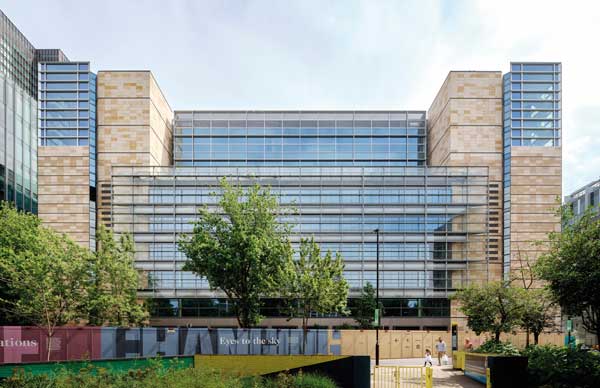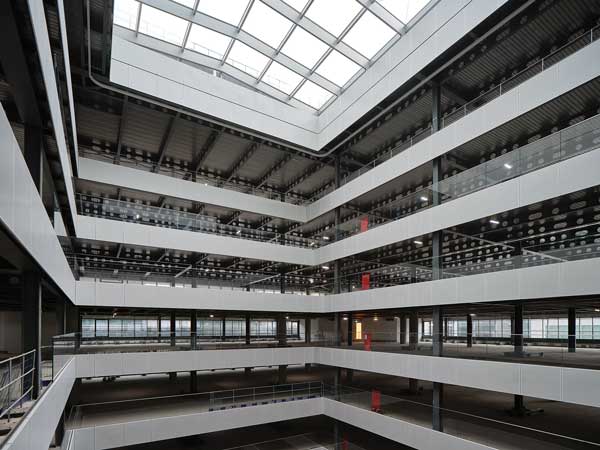SSDA Awards
AWARD: 1 Triton Square, London
A 1990s office block has been redeveloped with steel construction in order to double its floor area and create an exemplary sustainable and healthy workplace.
FACT FILE
Architect: Arup Associates
Structural engineer: Arup
Steelwork contractor: William Hare Ltd
Main contractor: Lendlease
Client: British Land
An increasing trend in the construction sector is the refurbishment and enlargement of existing office blocks, which is a cost-effective and sustainable alternative to demolishing the building and starting again with a blank canvas.
An example of this trend is 1 Triton Square, which was originally built for the First National Bank of Chicago and opened in 1997. This concrete-framed office building was the first structure to be completed at Regent’s Place, a 13-acre fully managed mixed-use campus on the north side of London’s Euston Road.
Lendlease Project Director Chris Carragher says the decision to refurbish the building instead of demolishing it was all about creating the most sustainable construction solution possible and is testament to British Land’s sustainable values.
“Refurbishing a project is a more environmentally-friendly option, as well as being cost-effective.”
Further highlighting the benefits of the chosen construction method, a 43% cost saving was made compared to a typical commercial building job, while overall it was 30% quicker to complete.
According to Arup Structural Lead Andrew Robertson there have been significant carbon savings for this refurbishment compared with a new build equivalent.
“About 35,000t of concrete and 1,900t of steel have been re-used and saved from demolition. The re-use of the structure and façade elements has resulted in carbon savings equivalent to a gas and electricity emission-free operation for 26 years.”
Employing the same design consultant from the original scheme, the existing five-storey building has been extended upwards with the addition of three new steel-framed office floors and a rooftop plant level.
Meanwhile, an unusually large 36m-wide atrium has been partially infilled with one new bay of steelwork all the way around, creating more office space for each of the existing floors and a smaller but still impressive 18m-wide atrium space.
Steelwork for the new upper floors is based around a 9m column grid pattern, in line with the existing structure’s layout. For the new infill floor areas inside the atrium, a series of long beams create an open-plan floor area.
These new floor beams are all approximately 18m long, but vary in length due to the atrium stepping in and out at every floor with balconies and breakout spaces.
The atrium starts at level one, as this was originally designed as a large trading floor and extends across the building’s entire footprint and also has a slightly higher floor-to-ceiling height.
The new nine-storey building is now centred around this reconfigured atrium, which will provide links between floors via internal feature staircases.
All the new steelwork for the scheme is either founded on the existing steel cores or off the existing main frame. Within the atrium, the existing structure was cut and carved down to the basement to allow new lift pits and a ground slab to be constructed, from which the new steelwork for the atrium was erected.
The new scheme has resulted in the existing structure being exposed to significant increases in loading. As a result, prior to steelwork contractor William Hare beginning its package, Lendlease had to undertake preliminary works that included strengthening existing concrete columns as well as installing 180 new piles in preparation for the new steelwork. This early work also included the removal of a steel-framed glazed roof that covered the atrium.
The addition of three new storeys translates to a significant increase of the horizontal loads on the building. Despite the new scheme making use of the existing frame to take some of these stability loads, the capacity of the existing bracing system was exceeded.
Therefore, before starting to add the new steelwork to the cores, the existing diagonal braces were sequentially replaced to accept the additional loads. The new levels required some complex column base connections in the cores as the original steelwork below was found to be out of position in some locations.
Where possible, the strengthening of existing steel core columns was typically undertaken by welding steel plates to the existing UC sections. The majority of these plates were positioned between the flanges of the UC section, allowing the size of the columns to remain largely unchanged while achieving a significant increase in capacity. Work within the existing cores was heavily constrained due to the adjacent precast façade, and so the plate strengthening was arranged to suit the limited access. The steel plate strengthening option was significantly lighter than the concrete encasement option, limiting the impact on the structure below.
British Land set high sustainability aspirations for 1 Triton Square through their Sustainability Brief for Developments, which sets targets for exemplary Wellbeing, Community, Futureproofing, and Skills and Opportunities. The project was awarded a BREEAM ‘Outstanding’ rating and has been named one of the UK’s most sustainable HQs.
Summing up, the judges say this outstanding project is an exemplar of sustainability thanks to the use of steel. It demonstrates how an existing building can be almost doubled in floor area, for a fraction of the embodied carbon of a new building the same size.











